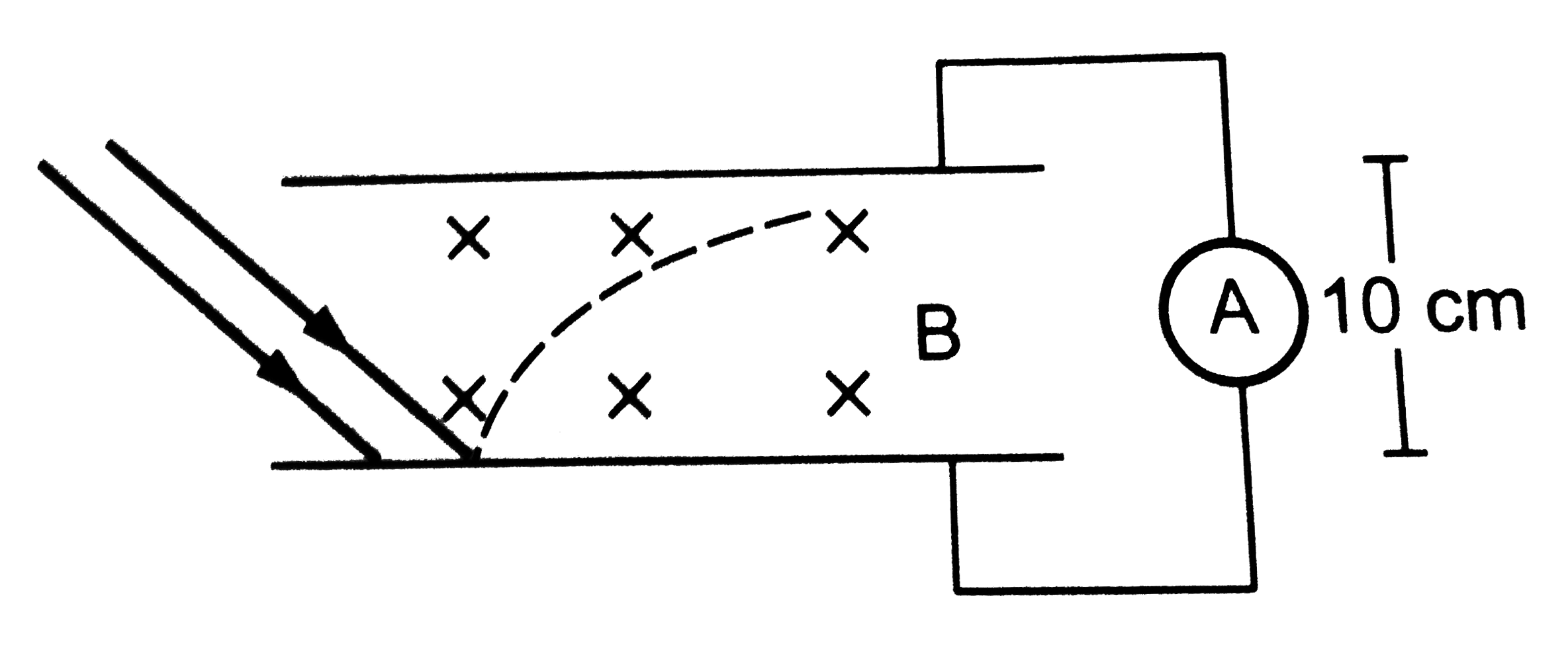Two metallic plates P(collector) and Q (emitter) are separated by a distance of 0.2 m. These are connected through an 0.2 m. These are connected through an ammeter without any cell. A magnetic field B exists parallel to the plates. Light of wavelengths between 2000 Å and 3000 Å fall of the plate Q whose work function is 2.22 eV.
The minimum value of B for which the current registered with ammeter is zero, is
3.8×10−5T
4.7×10−5T
6.7×10−5T
8.6×10−5T
The correct Answer is:C
Topper's Solved these Questions
- ELECTRONS AND PHOTONSBOOK - TARGET PUBLICATIONCHAPTER - ELECTRONS AND PHOTONSEXERCISE - Competitive Thinking
78 Videos
- COMMUNICATION SYSTEMSBOOK - TARGET PUBLICATIONCHAPTER - COMMUNICATION SYSTEMSEXERCISE - Evaluation Test
15 Videos
- FORCE BOOK - TARGET PUBLICATIONCHAPTER - FORCE EXERCISE - Evaluation Test
16 Videos
Similar Questions
Two metallic plates P (collector) and Q (emitter) are separated by a distance of 0.10 meter. These are connected through an ammeter without any cell. A magnetic field B exists parallel to the plates. Light of wavelength between 4000Åand6000Å fall on the plate whose work function is 2.39eV. Calculate the minimum value of B for which the current registered with ammeter is zero. Use, h=6.6×10−34Js,e=1.6×10−19C
View SolutionIn an experiment on photoelectric effect, the emitter and the collector plates are placed at a separation of 10cm and are connected through an ammeter without any cell.

A magnetic field B exists parallel to the plates. The work function of the emitter is 2.39 e V and the light incident on it has wavelengths between 400nm and 600nm. Find the minimum value of B for which the current registered by the ammeter is zero. Neglect any effect of space charge.
View Solution
Knowledge Check
A radiation of 2000Å falls on the metal whose work function is 4.2 eV. Then the kinetic energy of the fastest photo eletron is
A6.4×10−10 JB16×10−10 JC1.6×10−19 JD3.2×10−19 JLight of wavelength 5000Å falls on a sensitive plate with photoelectric work function of 1.9eV. The kinetic energy of the photoelectron emitted will be
A0.58eVB2.48eVC1.24eVD1.16eVLight of wavelength 5000Å falls on a sensitive plate with photoelectric work function of 1.9eV. The kinetic energy of the photoelectron emitted will be
A0.58 eVB2.48 eVC1.24 eVD1.16 eV
In an experiment on photoelectric effect, the emitter and the collector plates are placed at a separation of 10cm and are connected through an ammeter without any cell. A magnetic field B exists parallel to the plates. The work function of the emitter is 2.39 e V and the light incident on it has wavelengths between 400nm and 600nm. Find the minimum value of B for which the current registered by the ammeter is zero. Neglect any effect of space charge.

View SolutionIn a photocell the plates P and Q have a separation of 5 cm, which are connected through a galvanometer without any cell. Bichromatic light of wavelengths 4000Å and 6000Å are incidenton plate Q whose work- functionis 2.39 eV. If a uniform magnetic field B exists parallel to the plates, find the minimum value of B for which the galvanometer shows zero deflection.
View SolutionIn a photocell the plates P and Q have a separation of 5 cm, which are connected through a galvanometer without any cell. Bichromatic light of wavelengths 4000Å and 6000Å are incidenton plate Q whose work- functionis 2.39 eV. If a uniform magnetic field B exists parallel to the plates, find the minimum value of B for which the galvanometer shows zero deflection.
View SolutionLight of wavelength 5000Å falls on a sensitive plate with photoelectric work function of 1.9eV. The kinetic energy of the photoelectron emitted will be
View SolutionLight of wavelength 3000 Å falls on a metal surface having work function 2.3 eV. Calculate the maximum velocity of ejected electrons.
(Planck's constant , h=6.63×10−34 J.s. , velocity of light c=3×108m/s , mass of an electron = 9.1×10−31 kg )
View Solution
